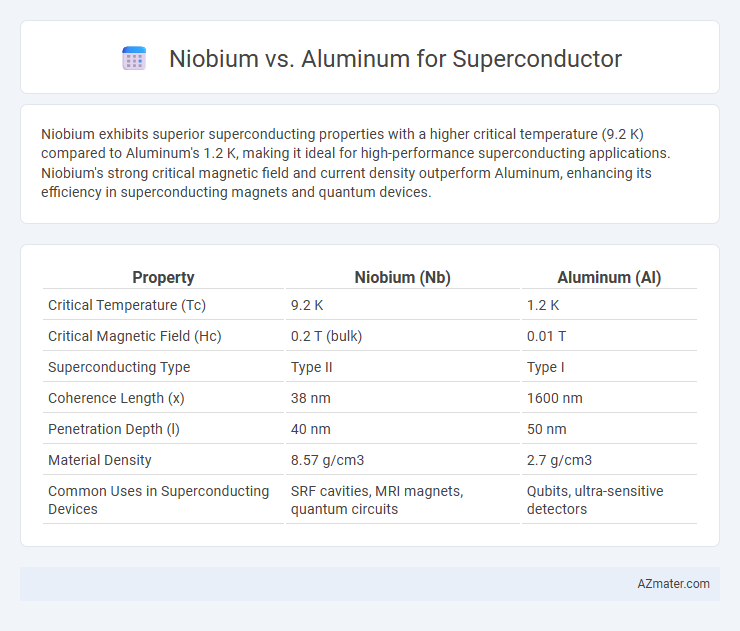Niobium exhibits superior superconducting properties with a higher critical temperature (9.2 K) compared to Aluminum's 1.2 K, making it ideal for high-performance superconducting applications. Niobium's strong critical magnetic field and current density outperform Aluminum, enhancing its efficiency in superconducting magnets and quantum devices.
Table of Comparison
| Property | Niobium (Nb) | Aluminum (Al) |
|---|---|---|
| Critical Temperature (Tc) | 9.2 K | 1.2 K |
| Critical Magnetic Field (Hc) | 0.2 T (bulk) | 0.01 T |
| Superconducting Type | Type II | Type I |
| Coherence Length (x) | 38 nm | 1600 nm |
| Penetration Depth (l) | 40 nm | 50 nm |
| Material Density | 8.57 g/cm3 | 2.7 g/cm3 |
| Common Uses in Superconducting Devices | SRF cavities, MRI magnets, quantum circuits | Qubits, ultra-sensitive detectors |
Introduction to Superconductors: Niobium vs Aluminum
Niobium and aluminum differ significantly in their superconducting properties, making niobium a preferred choice for high-performance superconducting applications due to its higher critical temperature of 9.2 K compared to aluminum's 1.2 K. Niobium's ability to maintain superconductivity under stronger magnetic fields and higher current densities enhances its use in MRI machines, particle accelerators, and quantum computing. Aluminum, while easier to fabricate and beneficial for low-temperature quantum circuits, is limited by its lower critical temperature and weaker magnetic field tolerance.
Physical and Chemical Properties Comparison
Niobium exhibits superior superconducting properties compared to aluminum, with a higher critical temperature of approximately 9.3 K versus aluminum's 1.2 K, making niobium more effective for practical superconducting applications. Chemically, niobium forms a stable oxide layer that enhances corrosion resistance, whereas aluminum's oxide layer provides lightweight durability but less superconducting efficiency. Physically, niobium has a higher melting point (2477degC) and density (8.57 g/cm3) compared to aluminum's melting point of 660degC and density of 2.70 g/cm3, contributing to niobium's robustness under extreme conditions in superconducting devices.
Critical Temperature: Niobium vs Aluminum
Niobium exhibits a significantly higher critical temperature (Tc) of approximately 9.2 K compared to aluminum's critical temperature of about 1.2 K, making niobium more suitable for superconducting applications requiring higher operating temperatures. The elevated Tc of niobium enhances its efficiency and stability in superconducting magnets and quantum devices. This contrast in critical temperatures directly impacts material selection in superconducting circuits and sensors.
Superconducting Performance and Efficiency
Niobium exhibits superior superconducting performance compared to aluminum, with a critical temperature (Tc) around 9.3 K, significantly higher than aluminum's Tc of 1.2 K, enabling more efficient superconducting operation at relatively higher temperatures. Niobium's higher critical magnetic field and current density enhance its efficiency in practical applications such as MRI magnets and particle accelerators. Aluminum's lower superconducting parameters limit its use to ultra-low temperature environments, making niobium the preferred material for high-performance superconducting devices.
Fabrication and Cost Considerations
Niobium offers superior superconducting properties and higher critical temperatures compared to aluminum, making it preferred for high-performance applications despite its complex fabrication processes that often require ultra-high vacuum environments and precise deposition techniques. Aluminum is easier and less costly to fabricate due to its simpler sputtering or evaporation methods and lower material cost, but its lower critical temperature limits performance in many superconducting devices. Cost considerations heavily favor aluminum for large-scale, budget-sensitive projects, while niobium's expense is justified in applications where enhanced superconducting efficiency and durability are critical.
Magnetic Field Response and Stability
Niobium exhibits superior magnetic field response compared to aluminum due to its higher critical magnetic field, which allows it to maintain superconductivity under stronger magnetic environments. The stability of niobium is enhanced by its robust flux pinning properties, reducing the risk of flux creep and quenching in high-field applications. Aluminum, with a lower critical field and weaker flux pinning, is generally less stable in intense magnetic fields, limiting its use in high-performance superconducting magnets.
Applications in Modern Technology
Niobium is preferred for superconducting applications due to its higher critical temperature and magnetic field tolerance compared to aluminum, making it ideal for MRI machines, particle accelerators, and quantum computing. Aluminum superconductors are mainly used in low-temperature electronics and research setups where ease of fabrication and cost are prioritized over performance. Advanced technologies increasingly rely on niobium's superior superconducting properties to achieve higher efficiency and stability in power transmission, medical imaging, and high-performance sensors.
Advantages and Limitations of Niobium
Niobium exhibits superior superconducting properties compared to aluminum, including a higher critical temperature of 9.2 K versus aluminum's 1.2 K, enabling more practical applications in superconducting magnets and quantum devices. Its high critical magnetic field and critical current density enhance performance under strong magnetic environments, crucial for MRI machines and particle accelerators. However, niobium's higher material cost and fabrication complexity pose limitations compared to aluminum's abundance and ease of processing.
Pros and Cons of Aluminum as a Superconductor
Aluminum as a superconductor offers advantages such as a low critical temperature around 1.2 K and excellent ductility, making it easier to fabricate into thin films and nanostructures compared to niobium. It has a relatively simple and well-understood electron-phonon interaction, which helps achieve high coherence in qubits for quantum computing applications. However, aluminum's lower critical magnetic field and critical temperature limit its use in high-field or high-temperature superconducting devices, where niobium's higher critical temperature (~9.3 K) and stronger robustness to magnetic fields provide significant performance benefits.
Future Trends and Research Directions
Niobium, especially in its alloyed forms like Nb-Ti and Nb3Sn, remains a dominant superconductor due to its high critical temperature and magnetic field strengths, driving research towards enhancing its performance in high-field applications such as MRI and particle accelerators. Aluminum, while having a lower critical temperature, is gaining attention for quantum computing and nanoelectronics because of its ease of fabrication and compatibility with superconducting qubits. Future research is focused on optimizing niobium-based compounds for higher efficiency and exploring aluminum's potential in hybrid superconducting circuits to enable scalable and robust quantum devices.

Infographic: Niobium vs Aluminum for Superconductor
 azmater.com
azmater.com